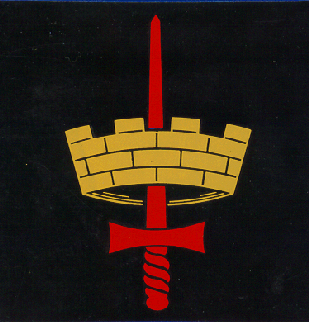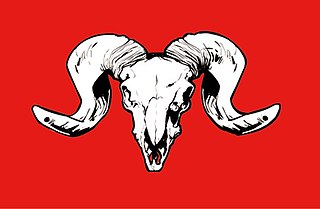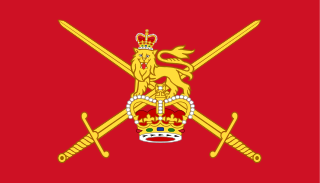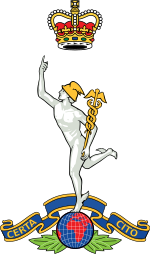
The Royal Corps of Signals is one of the combat support arms of the British Army. Signals units are among the first into action, providing the battlefield communications and information systems essential to all operations. Royal Signals units provide the full telecommunications infrastructure for the Army wherever they operate in the world. The Corps has its own engineers, logistics experts and systems operators to run radio and area networks in the field. It is responsible for installing, maintaining and operating all types of telecommunications equipment and information systems, providing command support to commanders and their headquarters, and conducting electronic warfare against enemy communications.

London District (LONDIST) is the name given by the British Army to the area of operations encompassing the Greater London area. It was established in 1870 as Home District.

The 30th Armoured Brigade was an armoured formation of the British Army that served in Western Europe Campaign as part of the 79th Armoured Division. After the reformation of the Territorial Army in 1947, the brigade was re-created within the Territorials based in Scotland and finally disbanded by 1967.

The 11th Security Force Assistance Brigade is a brigade of the British Army which is intended to train and assist foreign forces. In 2021, under the Future Army changes, the brigade was redesignated, formerly being the 11th Infantry Brigade & HQ South East. Prior to the Army 2020 changes in 2013, the brigade was temporarily activated for deployment to Afghanistan, and before that engaged during the two World Wars.
The 19th Brigade is an Army Reserve brigade of the British Army. As the 19th Infantry Brigade it fought in the First and Second world wars.

36 (Eastern) Signal Regiment was a Territorial Army (TA) signal unit of the British Army's Royal Corps of Signals (RCS). The regiment was formed following the formation of the TAVR in 1967, and was disbanded in 2009 following a reorganisation in the RCS. Though not disbanded, the regiment continues its lineage as a squadron, with its own former squadrons forming troops within said squadron.

The 31st Signal Regiment was a territorial communications regiment of the British Army's Royal Corps of Signals. The regiment first formed following the creation of the Territorial and Army Volunteer Reserve in 1967 after the 1966 Defence White Paper. After seeing limited reserve support during the Cold War, the regiment was disbanded in 2010 following the initial Army 2020 reform.

The 11th Signal Brigade and Headquarters West Midlands is a signal formation of the British Army's 3rd UK Division. Its headquarters is located at Venning Barracks, in Donnington in Shropshire.

The 1st Signal Brigade, formerly known as the 1st Signal Group, is a brigade of the British Army. The group was first formed in 1968 as a result of the 1966 Defence White Paper which expanded support for NATO and the British Army of the Rhine. In 1987 the group was disbanded and merged into the 2nd Signal Brigade. In 1995 the brigade was reformed and has since deployed on operations across the globe in support of NATO and HQ Allied Rapid Reaction Corps.

The 1st Artillery Brigade was a support formation of the British Army as part of the 3rd Division, and oversaw all close support artillery and deep fires units of the army. Under the Future Soldier programme, the brigade merged with 1st Armoured Infantry Brigade to form 1st Deep Recce Strike Brigade Combat Team.

The structure of the British Army of the United Kingdom (UK) is currently being reorganised to the Future Soldier structure. Due to these reforms taking place gradually, it is likely that some areas will not be fully complete. The British Army is commanded by the Chief of the General Staff (CGS), with Army Headquarters which is located in Andover, Hampshire. Subordinate to that post, there is a Commander Field Army, and a personnel and UK operations command, Home Command.
The following is a hierarchical outline for the structure of the British Army in 1989. The most authoritative source for this type of information available is Ministry of Defence, Master Order of Battle, and United Kingdom Land Forces, HQ UKLF, UKLF ORBAT Review Action Plan, HQ UKLF, 1990.

The 12th Signal Brigade, later 12th Signal Group was a military communications formation of the British Army commanding regiments of the Royal Corps of Signals. Initially formed in 1967, the brigade would provide rear defence communications for the British Army of the Rhine until its disbandment in 1992. In 2004, the group was reformed to provide territorial army and rear support to the Allied Rapid Reaction Corps in Germany. However, in 2009 the group was disbanded following reductions to the Royal Corps of Signals and Territorial Army.
The 10th Signal Regiment is a current regiment of the Royal Corps of Signals within the British Army.
The 4th Signal Group was a group sized unit of the Royal Corps of Signals within the British Army that supported the British Army of the Rhine. The group's main job was to supervise all of the static communications used by the British Forces in Germany. It supported the British Army of the Rhine and 2nd Allied Tactical Air Force for just under 30 years.

The 13th Signal Regiment is a specialist signals unit of the Royal Corps of Signals of the British Army. Originally formed in 1934, the regiment had a long history of service before being disbanded in 1994 following the initial Options for Change reforms. The regiment was be reformed in June 2020 as part of 1st Signal Brigade.

The 15th Signal Regiment is military communications unit of the British Army's Royal Corps of Signals.

Central Volunteer Headquarters, Royal Corps of Signals is a special administrative group of the Royal Corps of Signals formed to oversee the national reserve units of the corps.
Future Soldier is a reform of the British Army resulting from the Integrated Review of Security, Defence, Development and Foreign Policy published in March 2021. The aim of the reform is to create a more lethal, agile and expeditionary force, able to fight and win wars and to operate in the grey-zone between peace and war. Future Soldier was published on 25 November 2021 and deals with the organizational changes of the British Army, with changes to personnel and equipment were set out in the Defence in a Competitive Age paper published on 22 March 2021.

The Cyber and Electro Magnetic Activities Effects Group is a combat support formation of the British Army due to form by late 2022. The group will bring together three specialist regiments of the Royal Corps of Signals under Commander Field Army.













